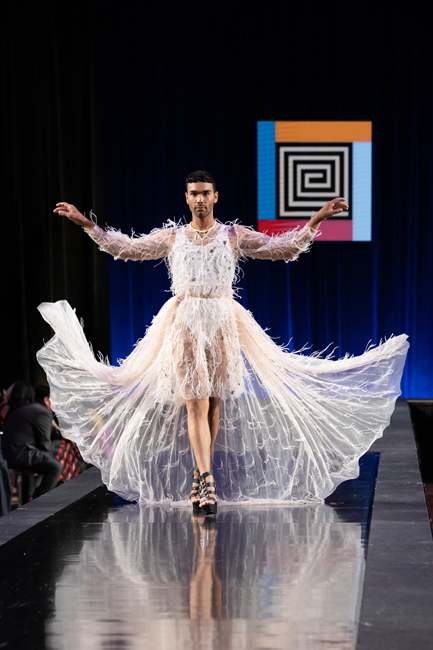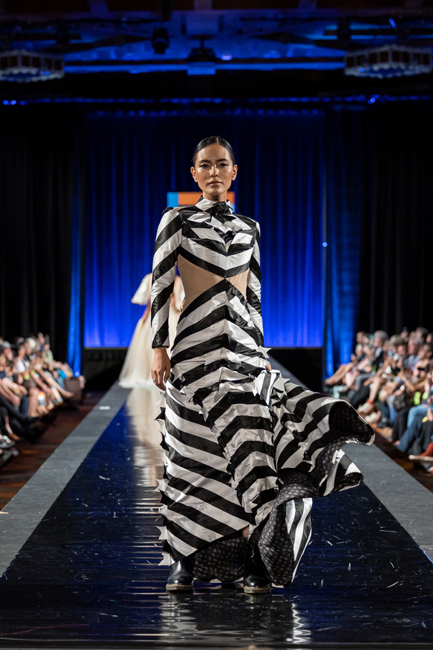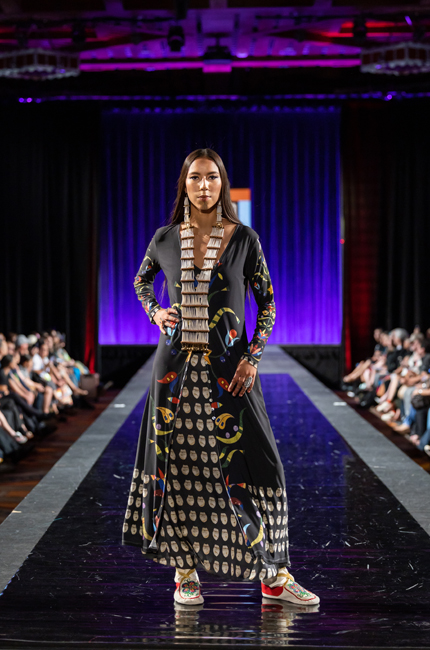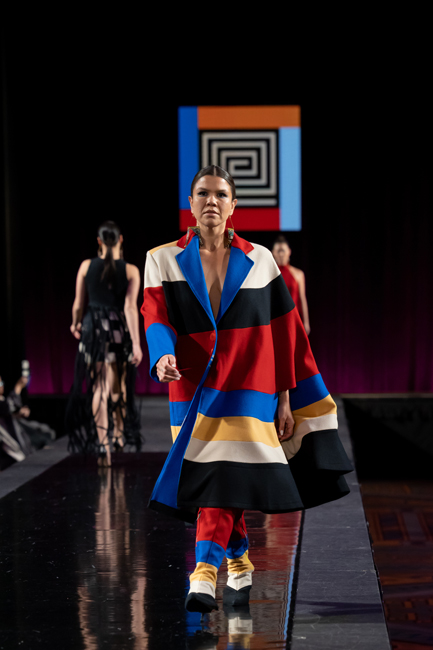The Santa Fe Indian Market fashion show shined a spotlight on Indigenous designers who bring new perspectives to an industry in need of positive, equitable change.

SANTA FE—The weekend of August 20, 2022, marked the 100th anniversary of the Southwestern Association for Indian Art’s annual Market, and with that, an amplified presentation of leading Indigenous fashion designers during the fashion show. Now in its ninth year, the event featured a robust lineup of fourteen designers, ranging from prêt-à-porter, streetwear, eveningwear, and couture, and showcased a spectrum of Indigenous talent, creativity, and politics.
The presentation on Sunday afternoon marked the premiere of interdisciplinary artist Skawennati’s fashion line Calico and Camouflage in the artist’s first runway show. Featuring a blend of streetwear, protest wear, and Indigenous cyberpunk futurism, the collection connected a clear line back to the clothing worn by the artist’s avatars in her digital work and installations, including full environments she creates in the Second Life platform. The show was part fashion runway, part protest, with runway models carrying signs reading “Water is Life” and “Resistance is Fertile.” The clothes comprised of calico print cargo pants and camouflage ribbon shirts—the artist created a pastiche between Native motifs like ribbon work, and a futuristic digital camo in bold colors like hot pink and vibrant blue.
Amber-Dawn Bear Robe from the Siksika Nation in Alberta, Canada organized the two-day SWAIA Fashion Show, which represents a critical moment each year for Indigenous designers to showcase their work on their terms. Vogue writer Christian Allaire (Ojibwe), who was in attendance, has long been a supporter of Indigenous designers, and uses his platform with one of the country’s leading fashion magazines to amplify events like the SWAIA show. His work, and fashion shows such as the SWAIA event, de-ghettoize the work of these designers and allow their collections to be experienced by a broader audience.
“Native fashion is a pillar of American fashion, and it is only growing,” he shared.
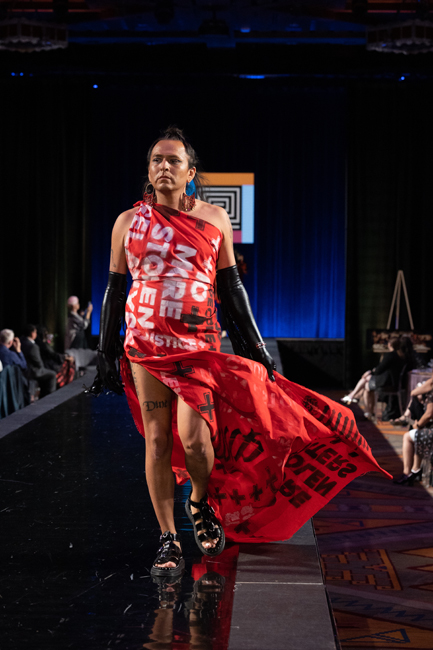
This pillar, however, needs to be engaged with via a labor model that is steeped in equitability and sustainable practices—sustainability not only in how big fashion includes, engages, and incorporates Indigenous designers into the fold, but also sustainability of material and production, distribution, and storytelling.
Project Runway alum Korina Emmerich and her eponymous label Emme Studio shined bright Saturday evening with an impactful combination of primary colors and clean lines, fringe, and color blocking that hinged on the artist’s commitment to sustainably sourced materials and production. One standout from Emme Studio was the Murdered and Missing Indigenous Persons banner gown worn by multidisciplinary artist Demian DinéYazhi’. The long red gown was scribed with various phrases—the most prominent being “no more stolen relatives”—that referenced the ongoing violence that faces Indigenous communities, specifically women, trans, and two-spirit individuals who are most likely to experience sexual violence and murder in the United States and Canada. Emmerich’s practice regularly incorporates politics and activism; she is a member of Indigenous Kinship Collective, works as a community organizer in Brooklyn, and acts as a special advisor for Slow Factory.
Diné designer Orlando Dugi eschewed gendered clothing tropes and explored exaggerated shapes and luxe sheer materials in his first menswear collection. Black lace button-down shirts felt fresh and were imbued with a timeless sexiness when paired with double-pleated shorts and high-shine black loafers. Dugi’s palazzo tuxedo pants were effortless and forward paired with knit sweaters woven from wool sourced from New Mexico sheep farmers. The designer incorporates nods and traces of his Indigeneity both in material and design elements, while simultaneously creating work that isn’t solely defined by it. The results spoke for themselves.
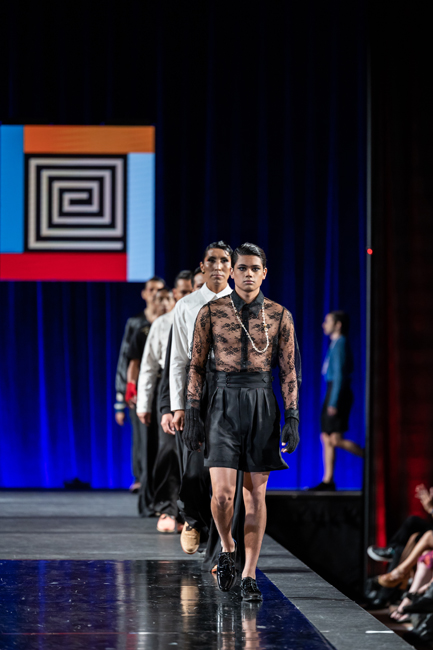
The current-day results and conditions of industry equity and sustainability, however, are lagging. A sustainable labor model must evolve past rampant historic appropriation by mainstream fashion houses—both at the ready-to-wear level and high-end designers—of Indigenous design aesthetics and motifs and emerge to be inclusive and honest about contributions that Indigenous artists and designers have made and continue to make to the visual and material culture fields.
Because of this uneven labor model, the urgency for more representation of Indigenous artists and designers is crucial; that is why events, such as the SWAIA fashion show and Indigenous fashion weeks in Vancouver and Toronto, are more critical than ever. These events provide an uninterrupted, self-determined platform in which Indigenous creatives can make and show work that is reflective of their cultural backgrounds and communities without feeling forced to sit exclusively in that space. Essentially, it gives a platform for artists who can design however they want. Indigenous designers in the fashion industry today intersect their work with both historically used techniques and materials as well as contemporary fabrics, aesthetics, and design ideologies, creating a continuum of Indigenous style and expression.
The SWAIA fashion show also featured Jamie Okuma (La Jolla Band of Indians)—who, along with Emmerich, was featured in the Metropolitan Museum of Art’s Costume Institute exhibition In America: A Lexicon of Fashion in 2021—and Patricia Michaels (Taos Pueblo), who was the first Indigenous designer featured on Project Runway. Other participating designers included Lauren Good Day (Arikara, Hidatsa, Blackfeet, Plains Cree), Catherine Blackburn (English River First Nation), Himikalas Pamela Baker (Musgamakw Dzawada’enuxw, Tlingit, Haida, Squamish), Sho Sho Esquiro (Kaska Dena, Cree, Scottish), Jason Baerg (Métis Nation of Ontario), Dorothy Grant (Haida), Melanie LeBlanc (European, Dene), Yolonda Skelton (Gitxsan Nation), Ursala Hudson (Tlingit), and Lesley Hampton (Anishinaabe).
As SWAIA continues to expand its fashion presence, it will be exciting to see how the fashion industry embraces these designers, and other Indigenous designers working in the field—increasing equity and visibility for creatives deserving of it.
